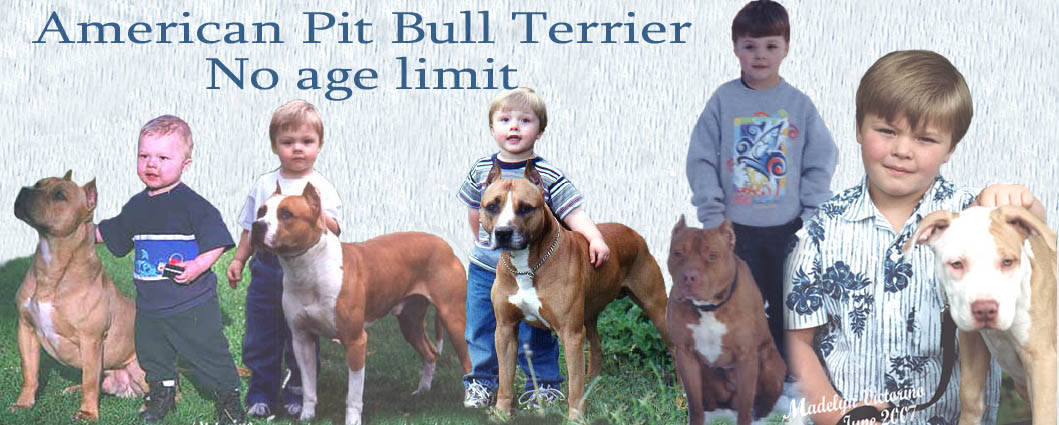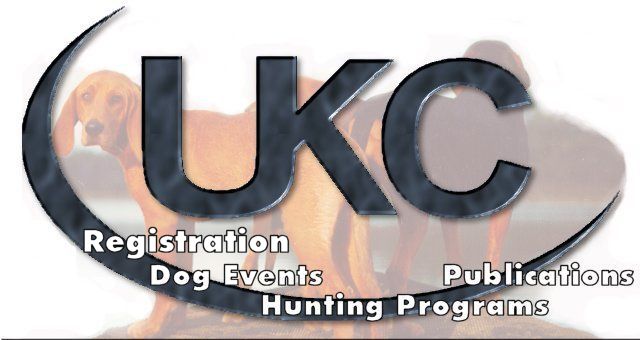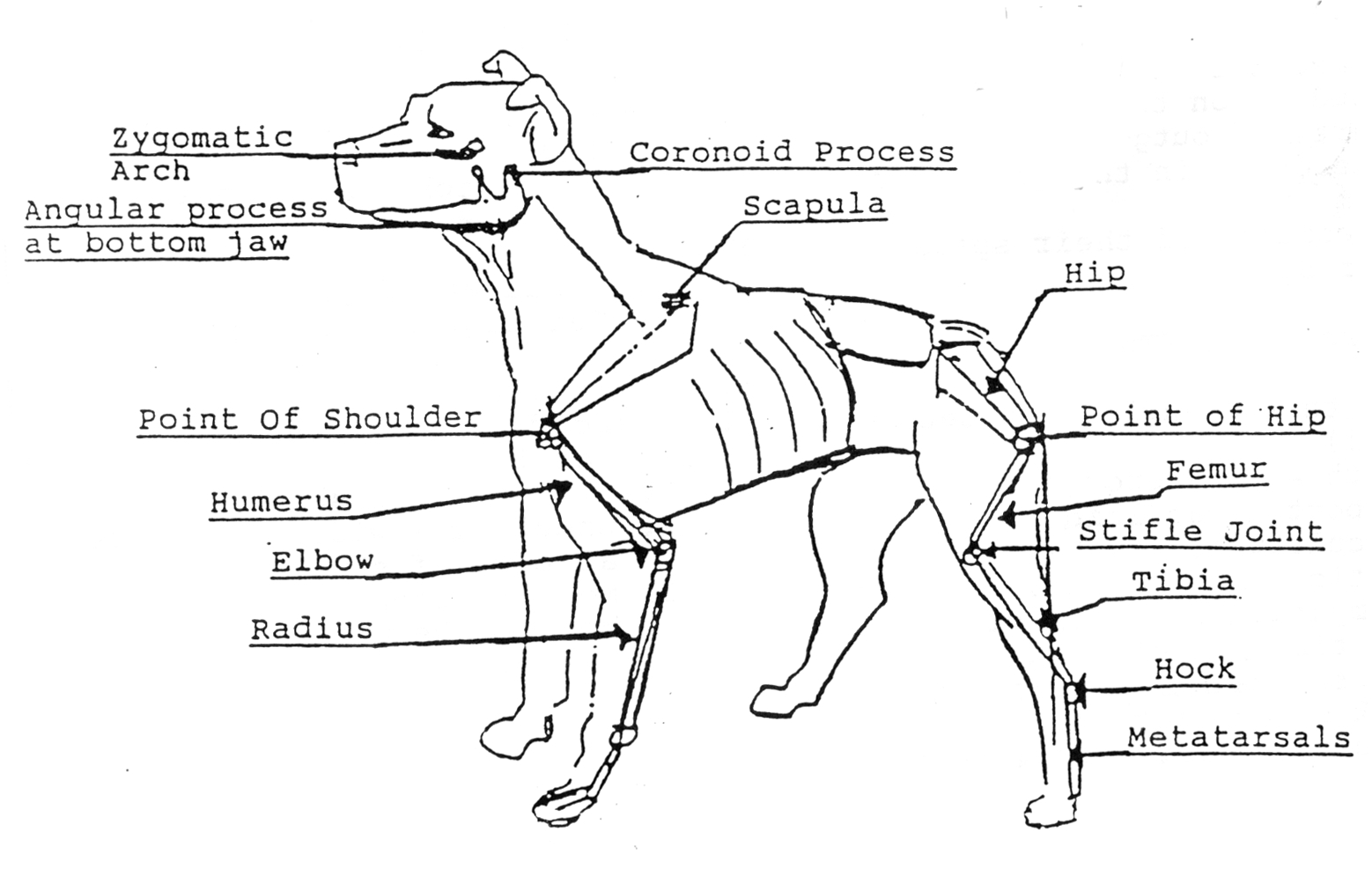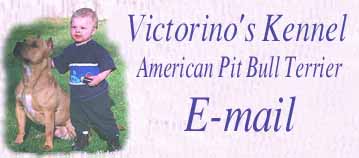|
|
|
|
|
|
|
|
|
|
|
|
|
|
|
|
|
|
|
|
|
|
| ADBA & UKC
American
Pit Bull Terrier Breed Standards
Page updated on 2/6/2007
|
|
|
|
|
|
|
|
|
ADBA Conformation Standard
American Pit Bull Terrier Breed Standard

|
|
|
|
|
|
HISTORY |
History of the ADBA
To truly understand any breed standard, one must know the history behind a breeds existence .
The purpose of a judge is the unbiased selection of quality breeding stock with true breed type
The responsibility of judging is to put up the dogs that conform most
to the conformation standard leaving personal bias aside.
The American Dog Breeders Association, Inc. was started in September, l909 as an exclusive association of American Pit Bull Terrier breeders. The residing president, Mr. Guy McCord, was an avid fancier and breeder of the dogs, and was a close friend of Mr. John P. Colby. Mr. Colby was the mainstay of the A.D.B.A. which prompted the boast of being the "home" registration office of the Colby dogs. All members, in good standing, could register their dogs and litters with the registration department upon the yearly payment of $2.50 dues fee. It seems that the exclusive members idea gradually was replaced into an open registry to all owners and breeders of purebred American Pit Bull Terriers, to act as an exclusive registry of the breed and insure the accuracy of this type of records keeping.
The paper issued at that time, was a one page, pink paper which on the top listed the description of the dog and other pertinent information necessary to serve as a title of ownership on the dog. On the bottom, it listed the pedigree, owner and breeder. We thought it interesting to note that on the reverse side of this paper it read, in part: "The American Pit Bull Terrier is now recognized as a standard breed, where a few years ago, it was un-recognized as a breed. The majority of the American public carried the impression that the American Pit Bull Terrier was synonymous with dogs used for fighting purposes only. This idea has been dispelled by persistent efforts of the breeders who compose this association. Presently, classes for American Pit Bull Terriers can be found at almost every local dog show being held. With concerted effort, our faithful friend will in time be classed as the leading American dog, who will give his life if necessary in defense of his master/mistress. We trust that you will unite with us in our efforts to bring this dog to the destiny he deserves. "The Standard dog of the U.S.A."
The A.D.B.A. passed from the hands of Mr. McCord to Mr. Frank Ferris in l951. He, along with his wife Florence Colby, (the wife of the late John P. Colby) continued to run the A.D.B.A. on a limited scale, but with ever increasing emphasis on the registration of the A.P.B.T. breed exclusively. In 1973, through the recommendation of Howard Heinzl, Ralph Greenwood and his family purchased the A.D.B.A. from Mr. Ferris, whose advancing age prompted his retirement. (Mr. Heinzl was a personal friend of Frank Ferris and a staunch supporter of the A.D.B.A., as he registered his dogs exclusively with A.D.B.A.) We often wish Frank could have lived to witness the growth of the present association. He would have been pleased.
In 1976, the A.D.B.A. was petitioned by the owners of the breed, who possessed a very competitive spirit, to develop a standard on the breed by which conformation dog shows could be held. They did not want a standard that copied those of the UKC or AKC, but a standard for those dogs that they owned and continued to breed for the traits of intelligence, character, loyalty, and the athletic prowess that the breed was originally bred for hundreds of years ago. Thereby, they could continue competition, in a legal endeavor. Thus, the formation of the A.D.B.A. Conformation Standard.
The publication of the American Pit Bull Terrier Gazette started about this same time, and the first issue (Volume 1 - Issue 1) was out of the printers August, l976. Our aim: To enlighten the public to the truth about the A.P.B.T. and promote the positive aspects of the breed, through the conformation shows and the weight pulling events. The Gazette is the official publication of the A.D.B.A. and offers articles of history, pedigrees, ads on dogs for sale and at stud, books on the breed that are available, a bit of humor, dog care, nutrition, show and pulling training, as well as a sounding board for those associated with the breed. We try to bring the past as well as the present to life for our readers, portraying our dogs as they were then, and are now today.
Our association continues to grow in the U.S.A. and other countries overseas. The American Dog Breeders Association Inc. is the largest registration office of the American Pit Bull Terrier. The A.D.B.A. registered American Pit Bull Terrier is the #1 breed of dog exhibited in the U.S.A. today, through conformation dog shows and weight pulling events sponsored by the American Dog Breeders Show Inc.
|
|
Conformation Standard |
ADBA Conformation Standard
The ADBA APBT Heritage Conformation Standard
now includes an ideal conditioned show weight to be
between 30 and 75 pounds.
I. Introduction
A. To truly understand any breed standard, one must
know the history behind a breed’s existence.
B. The purpose of a judge is the unbiased selection
of quality breeding stock with true breed type.
C. The responsibility of judging is to put up the
dogs that conform most to the conformation standard leaving personal
bias aside.
II. Overall Appearance 20 points
A. Conforming to breed type
1. Should look like an American Pit Bull Terrier from across the ring
2. Sturdy, three dimensional. Giving the impression of strength, not
slight or frail.
3. Appears square, with heavy boned, solid front end with a light
and springy back end.
4. Should look athletic, not bulky. Musculature should be smooth but
defined.
5. Presentation of an adult dog should be of a lean, exercised animal,
showing a hint of rib and backbone (without hipbones
showing) with muscles firm and defined. Clean, glossy coat with short
trimmed nails. Presentation of dogs in the puppy
classes should be of a well nourished puppy, showing no ribs, backbone
or hips. Coat should be glossy with short, trimmed
nails.
B. Balance
1. Balanced angulation of front and rear assembly - judged
best at the trot.
2. Height to weight ratio - the tallest dog at a
given weight
3. Head size in proportion to the body, with a neck
long enough to have 2/3rds of the head appear above the topline of
the back
when head is in a normal upright position.
C. Presentation
1. Dog is socialized, showing interest in things around him.
2. Although some degree of dog/animal aggressiveness
is characteristic of the breed, unruly behavior will detract from
the
judges ability to accurately judge an individual dog’s conformation.
D. Health
1. The vitality of the dog’s spirit, the gloss
of the dogs coat and the sharpness of the dog’s eye, will exude
the healthfulness of
the individual animal.
2. Colors or color patterns known to be genetically
linked to health problems will be considered a serious fault. Major
faults:
merle color pattern, albinism(white dog with blue or pink eyes, pink
nose, lips, no pigment present on pads, rims of eyes etc.)
III. Attitude 10 points
A. Confident and alert
B. Interested in things around them, in control of
their space, not threatened by anything in their surroundings.
C. Gentle with loved ones.
Major Fault: shy or timid.
IV. Back end 30 points
A. Loin
1. Broad and long enough to square the dog. Too short
can interfere with a dogs flexibility. Too long a loin causes the
dog to
carry excessive weight and affect a dog’s agility and quickness.
B. Hip
1. Long and sloping with adequate width. This can
be judged by the set of the tail, which should be low.
2. Ideal slope of hip should be 30 degrees to the
ground.
C. Proportions of the back leg.
1. The femur should be of a length so that the stifle
joint is proportioned in the upper 1/3 of the rear assembly.
2. The tibia-fibula is the longer bone of the rear
assembly
3. The length of the metatarsal is moderate, with
muscles that attach equally on each side of the bone so that the hocks
move
parallel to each other, deviating neither in nor out. The metatarsals
bones, hock and lower part of the tibia will be light, fine and springy.
4. Rear angulation - ratio between the lengths of
the bones and the muscles which attach on these bones, causes a bent
stifle which leads to a well bent hock. This contributes to the natural
springiness that is desired in the rear assembly.
5. The muscle attachment is long and deep, well past
the joint ideal for leveraged power, which causes the muscles to appear
smooth, but defined. (Not bunchy).
Faults: short or flat hip, straight stifle,
double jointed or slipped hock, cow hocked, bunchy muscles.
V. Front end 20 points
A. Ribcage
1. Deep and elliptical with a prominent breastbone
or prosternum. From the side, the bottom of the ribcage should at
least be
even with the elbow joint.
2. Well sprung at the top, tapering to the bottom,
extending well back into the loin.
B. Shoulders
1. Wider than the ribcage at the 8th rib. Scapula
well laid back, 45 degree or less angle to the ground, and broad and
flat
allowing for adequate muscular attachment for a heavy and sturdy front
end.
2. The humerus is angled at an opposite 45 degree
angle and is long enough that the elbow comes to the bottom of the
ribcage, elbows lying flat against the body.
3. Forearms are slightly longer than the humerus
and solid, twice the thickness of the metatarsal at the hock.
C. Feet
1. Small and tight, set high on pasterns.
2. Pads thick, and well built up.
3. Dew claws are natural on front feet, and do not
naturally occur on back legs.
Faults: barrel chest, narrow chest, fine bones, out at elbows,
down in pasterns, splay feet, thin pads, back dew claws.
VI. Head and Neck 15 points
A. Neck
1. Heavily muscled to the base of the skull
2. Long in length
B. Head
1. Head size balanced in relationship to the rest
of the body.
2. 2/3 the width of the shoulders.
3. Wedge shaped when viewed from the top or side,
round when viewed from the front.
4. Cheeks 25% wider than the neck at the base of
the skull.
5. The length from the nose to the stop should equal
the length from the stop to the back of the head.
6. The bridge of the muzzle is well developed. The
fill in under the eyes should be wider than the head at the base of
the ears
for structural support of the upper canines.
7. The head should be deep from the top of the head
to the bottom of the jaw.
8. Straight box like muzzle
9. Lips tight
10. Teeth, incisors should meet in the front in a
scissor bite. Canines should be wide at the base and taper to the
end, top
canines fitting tightly together behind the bottom canines. They should
be sound and healthy with none missing.
11. Eyes, small and deep set. Elliptical when viewed
from the front, triangular when viewed from the side.
12. Ears- no preference should be given to cropped
or uncropped ears, except to enhance the overall attractiveness of
the
individual dog.
Faults: short neck, cheeky, underdeveloped muzzle, lippy, missing
canines, overshot or undershot to the extent that
the canines do not fit tightly together.
VII. Tail and Coat 5 points
A. Coat
1. Skin thick and loose around neck and chest, tight
fitting elsewhere, showing vertical folds around the neck and chest
even
in a well exercised animal.
2. Short and bristled, the gloss showing overall
health of the animal.
3. Color or any combination of colors, except for
colors or color patterns known to be genetically linked to health
problems.
B. Tail
1. Thick at the base, tapering to the point. Its
length should have the tail extending to the point of the hock.
2. Hang down like a pump handle when relaxed.
Major faults: Merle color pattern or albinism. (White
dog, blue or pink eyes, lacks pigment)
Faults: Longer coat, fringed hair on tail or elsewhere,
bobbed tail or any tail other than straight.
Disqualifications: Man aggression, one sided or both
sided cryptorchid, spayed or neutered dogs
Above all, the American Pit Bull Terrier should
appear to be an all around athlete. His body is called upon for speed,
power, agility and stamina. He must be balanced in all directions.
Too much of one thing, robs him of another. In his ideal form, he
is a thing of beauty The ADBA APBT Conformation Standard now includes
an ideal conditioned show weight to be between 30 and 75 pounds.
|
American Dog Breeders Association
Featured "Ace" with this photo as their centerfold dog in the Fall 2005 Issue of the
American Pit Bull Terrier Gazette Volume 30 Issue 1 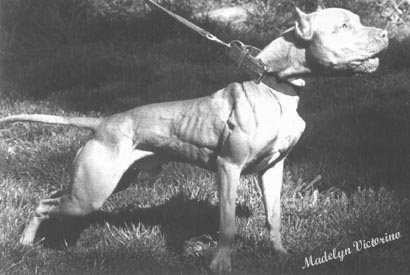
GRAND CHAMPION 1 ACE of ACE "VICTORINO'S REBELS RED ACE" |
|
|
|
|
|
|
|
|
|
United Kennel Club
American Pit Bull Terrier Breed Standard |
|
|
|
|
|
|
|
|
|
|
|
|
| HISTORY |
Sometime during
the nineteenth century, dog fanciers in England, Ireland, and Scotland
began to experiment with crosses between Bulldogs and Terriers, looking
for a dog that combined the gameness of the terrier with the strength
and athleticism of the Bulldog. The result was a dog that embodied all
of the virtues attributed to great warriors: strength, indomitable courage,
and gentleness with loved ones. Immigrants brought these bull and terrier
crosses to the United States. The American Pit Bull Terrier's many talents
did not go unnoticed by farmers and ranchers who used their APBTs for
protection, as catch dogs for semi-wild cattle and hogs, to hunt, to
drive livestock, and as family companions. Today, the American Pit Bull
Terrier continues to demonstrate its versatility, competing successfully
in Obedience, Tracking, Agility, Protection, and Weight Pulls, as well
as Conformation.
The United Kennel Club
was the first registry to recognize the American Pit Bull Terrier.
U.K.C. founder C. Z. Bennett assigned U.K.C. registration number 1
to his own APBT, Bennett's Ring in 1898.
|
| GENERAL
APPEARANCE |
The American Pit
Bull Terrier is a medium-sized, solidly built, short-coated dog with
smooth, well-defined musculature. This breed is both powerful and athletic.
The body is just slightly longer than tall, but bitches may be somewhat
longer in body than dogs. The length of the front leg (measured from
point of elbow to the ground) is approximately equal to one-half of
the dog's height at the withers. The head is of medium length, with
a broad, flat skull, and a wide, deep muzzle. Ears are small to medium
in size, high set, and may be natural or cropped. The relatively short
tail is set low, thick at the base and tapers to a point. The American
Pit Bull Terrier comes in all colors and color patterns. This breed
combines strength and athleticism with grace and agility and should
never appear bulky or muscle-bound or fine-boned and rangy.
Above all else, the APBT must have the functional capability to be a
catch dog that can hold, wrestle (push and pull), and breathe easily
while doing its job. Balance and harmony of all parts are critical components
of breed type.
Eliminating Faults: Any disproportionate overdone characteristic
(such as short legs, excessive bone or massive head or body) that would
interfere with physical activity or working ability.
Disqualifications: Unilateral or bilateral cryptorchid. Dwarfism.
|
| CHARACTERISTICS |
The essential characteristics
of the American Pit Bull Terrier are strength, confidence, and zest
for life. This breed is eager to please and brimming over with enthusiasm.
APBTs make excellent family companions and have always been noted for
their love of children. Because most APBTs exhibit some level of dog
aggression and because of its powerful physique, the APBT requires an
owner who will carefully socialize and obedience train the dog. The
breed's natural agility makes it one of the most capable canine climbers
so good fencing is a must for this breed. The APBT is not the best choice
for a guard dog since they are extremely friendly, even with strangers.
Aggressive behavior toward humans is uncharacteristic of the breed and
highly undesirable. This breed does very well in performance events
because of its high level of intelligence and its willingness to work.
Disqualifications: Viciousness or extreme shyness.
The American Pit Bull
Terrier has always been capable of doing a wide variety of jobs so
exaggerations or faults should be penalized in proportion to how much
they interfere with the dog's versatility.
|
| HEAD |
The
APBT head is unique and a key element of breed type. It is large and
broad, giving the impression of great power, but it is not disproportionate
to the size of the body. Viewed from the front, the head is shaped like
a broad, blunt wedge. When viewed from the side, the skull and muzzle
are parallel to one another and joined by a well defined, moderately
deep stop. Supraorbital arches over the eyes are well defined but not
pronounced. The head is well chiseled, blending strength, elegance,
and character.
Very Serious Fault: Overly large, heavy heads.
SKULL - The
skull is large, flat or slightly rounded, deep, and broad between the
ears. Viewed from the top, the skull tapers just slightly toward the
stop. There is a deep median furrow that diminishes in depth from the
stop to the occiput. Cheek muscles are prominent but free of wrinkles.
When the dog is concentrating, wrinkles form on the forehead, which
give the APBT his unique expression.
MUZZLE -
The muzzle is broad and deep with a very slight taper from the stop
to the nose, and a slight falling away under the eyes. The length of
muzzle is shorter than the length of skull, with a ratio of approximately
2:3. The top line of the muzzle is straight. The lower jaw is well developed,
wide and deep. Lips are clean and tight. Faults:
Snipey muzzle; flews; weak lower jaw.
Eliminating Faults: Muzzle so short and blunt as to interfere
with normal breathing.
TEETH - The American Pit Bull Terrier has a complete set of evenly spaced,
white teeth meeting in a scissors bite. Fault:
Level bite.
Serious
Faults:
Undershot, or overshot bite; wry mouth; missing teeth (this
does not apply to teeth that have been lost or removed by a veterinarian).
NOSE - The nose is large with wide, open nostrils. The nose may be any
color.
EYES - Eyes
are medium size, round to almond-shaped, and set well apart and low
on the skull. All colors are equally acceptable except blue, which is
a serious fault. Haw should not be visible.
Serious Faults: Bulging eyes; both eyes
not matched in color; blue eyes.
EARS - Ears are
high set and may be natural or cropped without preference. If natural,
semi-prick or rose are preferred. Prick or flat, wide ears are not
desired.
Disqualifications: Unilateral or bilateral deafness.
|
| NECK |
The neck is of
moderate length and muscular. There is a slight arch at the crest. The
neck widens gradually from where it joins the skull to where it blends
into well laid-back shoulders. The skin on the neck is tight and without
dewlap.
Faults:
Neck too short and thick; thin or weak neck; ewe neck; dewlap.
Very Serious Fault: A short, thick neck that would interfere with functional
ability
|
| FOREQUARTERS |
The shoulder blades
are long, wide, muscular, and well laid back. The upper arm is roughly
equal in length to the shoulder blade and joins it at an apparent right
angle.
The forelegs are strong
and muscular. The elbows are set close to the body. Viewed from the
front, the forelegs are set moderately wide apart and perpendicular
to the ground. The pasterns are short, powerful, straight, and flexible.
When viewed in profile, the pasterns are nearly erect.
Faults:
Upright or loaded shoulders; elbows turned outward or tied-in; down
at the pasterns; front legs bowed; wrists knuckled over; toeing in or
out.
Eliminating Faults: Front legs (measured from elbow to ground) shorter
than half the total height at the withers. Front legs so bowed as to
interfere with normal movement.
|
| BODY |
The
chest is deep, well filled in, and moderately wide with ample room for
heart and lungs, but the chest should never be wider than it is deep.
The fore chest does not extend much beyond the point of shoulder. The
ribs extend well back and are well sprung from the spine, then flattening
to form a deep body extending to the elbows. The back is strong and
firm. The top line inclines very slightly downward from the withers
to a broad, muscular, level back. The loin is short, muscular and slightly
arched to the top of the croup, but narrower than the rib cage and with
a moderate tuck-up. The croup is slightly sloping downward.
Very Serious Fault: Overly massive body style that impedes working
ability.
Eliminating Fault: Chest so wide as to interfere with normal movement. |
| HINDQUARTERS |
The hindquarters
are strong, muscular, and moderately broad. The rump is well filled
in on each side of the tail and deep from the pelvis to the crotch.
The bone, angulation, and musculature of the hindquarters are in balance
with the forequarters. The thighs are well developed with thick, easily
discerned muscles. Viewed from the side, the hock joint is well bent
and the rear pasterns are well let down and perpendicular to the ground.
Viewed from the rear, the rear pasterns are straight and parallel to
one another.
Faults:
Narrow hindquarters; hindquarters shallow from pelvis to crotch; lack
of muscle; straight or over angulated stifle joint; cow hocks; sickle
hocks; bowed legs.
|
| FEET |
The
feet are round, proportionate to the size of the dog, well arched, and
tight. Pads are hard, tough, and well cushioned. Dew claws may be removed.
Fault:
Splayed feet. |
| TAIL |
The
tail is set on as a natural extension of the top line, and tapers to a
point. When the dog is relaxed, the tail is carried low and extends approximately
to the hock. When the dog is moving, the tail is carried level with the
back line. When the dog is excited, the tail may be carried in a raised,
upright position (challenge tail), but never curled over the back (gay
tail).
Fault: Long tail (tail tip passes beyond
point of hock).
Serious Faults: Gay tail (not to be confused with challenge tail); kinked
tail.
Eliminating Fault: Bobbed tail.
Disqualification: Screw tail. |
| COAT |
The
coat is glossy and smooth, close, and moderately stiff to the touch.
Faults: Curly, wavy, or sparse coat.
Disqualification: Long coat. |
| COLOR |
Any color, color
pattern, or combination of colors is acceptable, except for merle.
Disqualifications: Albinism. Merle
|
| HEIGHT
AND WEIGHT |
The American Pit
Bull Terrier must be both powerful and agile so actual weight and height
are less important than the correct proportion of weight to height.
Desirable weight for a mature male in good condition is between 35 and
60 pounds. Desirable weight for a mature female in good condition is
between 30 and 50 pounds. Dogs over these weights are not to be penalized
unless they are disproportionately massive or rangy.
Very Serious Fault: Excessively large or overly massive dogs
and dogs with a height and/or weight so far from what is desired as
to compromise health, structure, movement and physical ability.
|
| GAIT |
The
American Pit Bull Terrier moves with a jaunty, confident attitude, conveying
the impression that he expects any minute to see something new and exciting.
When trotting, the gait is effortless, smooth, powerful, and well coordinated,
showing good reach in front and drive behind. When moving, the back
line remains level with only a slight flexing to indicate suppleness.
Viewed from any position, legs turn neither in nor out, nor do feet
cross or interfere with each other. As speed increases, feet tend to
converge toward center line of balance.
Faults:
Legs not moving on the same plane; legs over reaching; legs crossing
over in front or rear; rear legs moving too close or touching; rolling;
pacing; paddling; side winding; hackney action; pounding. |
| ELIMINATING
FAULTS |
|
(An Eliminating Fault is a Fault serious enough that it eliminates
the dog from obtaining any awards in a conformation event.)
Any disproportionate overdone characteristic (such as short legs,
excessive bone or massive head or body) that would interfere with
physical activity or working ability.
Muzzle so short and blunt as to interfere with normal breathing.
Front legs so bowed as to interfere with normal movement.
Front legs (measured from elbow to ground) shorter than half the total
height at the withers.
Chest so wide as to interfere with normal movement.
Bobbed tail.
|
|
DISQUALIFICATIONS |
(A dog with a Disqualification must
not be considered for placement in a conformation event, and must be reported
to UKC.)
Unilateral or bilateral cryptorchid.
Viciousness or extreme shyness.
Albinism.
Merle.
Unilateral or bilateral deafness.
Long coat.
Dwarfism
Screw tail
Note: Although some level of dog aggression is characteristic of this
breed, handlers will be expected to comply with UKC policy regarding dog
temperament at UKC events.
The docking of tails and cropping of ears in America is legal and remains
a personal choice. However, as an international registry, the United Kennel
Club, Inc. is aware that the practices of cropping and docking have been
forbidden in some countries. In light of these developments, the United
Kennel Club, Inc. feels that no dog in any UKC event, including conformation,
shall be penalized for a full tail or natural ears. |
|
SCALE OF POINTS |
| General
appearance, personality, obedience |
20 |
| Head,
muzzle, eyes, ears |
25 |
| Neck,
shoulder, and chest |
15 |
| Body |
15 |
| Legs and feet
|
15 |
| Tail,
coat and color |
10 |
Total |
100 |
|
|
|
|
|
|
|
 |
 |
 |
 |
 |
 |
 |
 |
 |
 |
 |
 |
